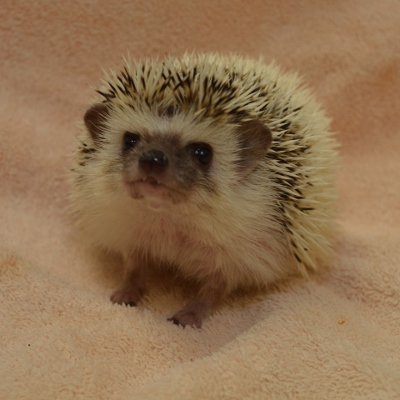
If you’ve been following us on Twitter @ExoticPetVets, you will have seen our tweet about how skilled hedgehogs are at jogging. And now they’re jogging into the sunset (perhaps to start looking for their nightly meals?) as their time as our Animal of the Month for September comes to an end. In case you missed any, here’s a summary of the fun and fascinating facts we tweeted over the past month. Did you know?:
- Hedgehogs are native to Europe, Africa and Asia, but the most common species kept as pets is the African pygmy hedgehog.
- The African pygmy hedgehog (Atelerix albiventris) is also called the four-toed, white-bellied or central African hedgehog.
- In the wild, hedgehogs don’t live in areas with extreme cold and can get heat stroke if it’s too hot.
- Hedgehogs tend to thrive in environmental temperatures ranging between 21º – 29ºC (70º – 85ºF).
- The body temperature of hedgehogs is lower than most mammals at 96º – 99º F (or 35.5º – 37 ºC).
- If the ambient temperature drops below 15º C (60º F), hedgehogs will be less active, which isn’t good for their health.
- Hedgehogs are nocturnal and tend to sleep during most of the day.
- In the wild, hedgehogs will jog kilometres a night seeking insects for their meals.
- Hedgehogs don’t have great vision, but they do have keen senses of smell and hearing.
- Hedgehogs are skilled at digging, jogging, swimming and climbing.
- Like all mammals hedgehogs have hair, but many of their hairs have evolved, joining together to form sharp keratin spines.
- Hedgehogs will curl into a ball as a defense mechanism, so their spines make them tricky to handle.
- The panniculus, the same muscle horses use to twitch flies off their backs, evolved to become specialized in hedgehogs.
- Frightened hedgehogs will contract the panniculus muscle which causes them to curl into a ball and raise their spines.
- If threatened, hedgehogs will jerk their body upward and thrust their spines into fingers or hands.
- If well socialized and gently handled, hedgehogs won’t curl into a ball too much and will make good pets.
- When hedgehogs forage for food, they make snuffling sounds.
- Hedgehogs will hiss loudly and make puffing or coughing noises when they’re irritated.
- Hedgehogs may scream if they’re in severe distress.
- There’s an unfortunate disease unique to African and European hedgehogs called Wobbly Hedgehog Syndrome (WHS).
- WHS slowly weakens hedgehogs’ muscle control in a manner that could be compared to MS in people.
- It’s unclear what causes WHS in hedgehogs, although it’s believed to be genetic with a possible dietary role.
- Did you know that hedgehogs spit on themselves? It’s a behaviour known as “self-anointing” or “anting.”
- Hedgehogs will put objects that have a strong or unusual odour into their mouths and mix it with lots of saliva.
- Hedgehogs will move their heads around to coat their backs with the saliva using their tongues when they “self-anoint.”
- There are various theories why hedgehogs self-anoint, with one being they’re camouflaging themselves with scent.
- Hedgehogs are widely represented in folklore and popular culture in many countries around the world.
- A satirical political party in New Zealand once tried – unsuccessfully – to get a hedgehog elected to Parliament.

